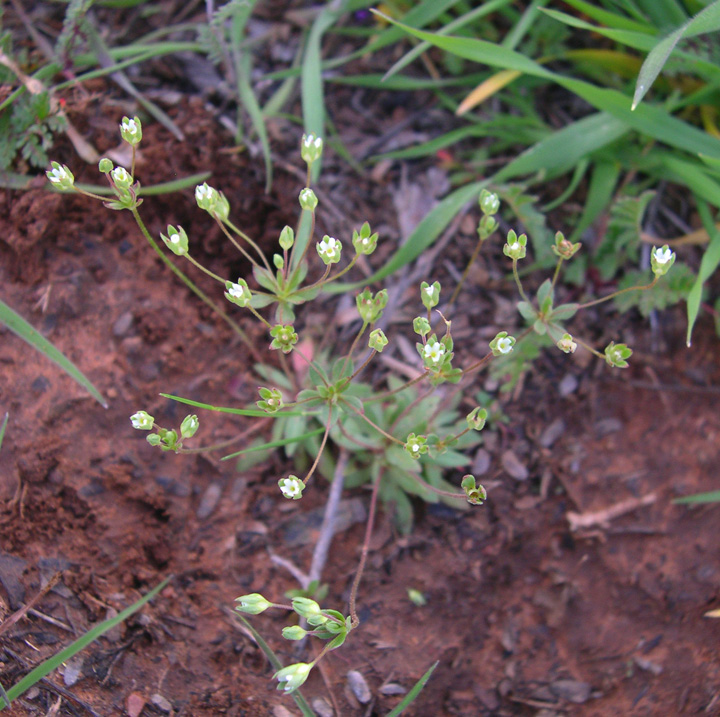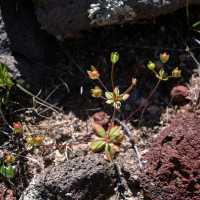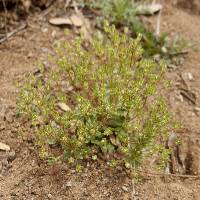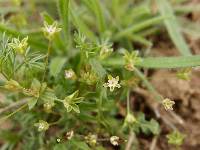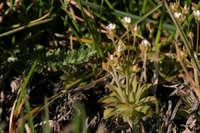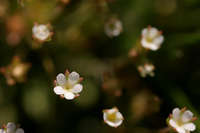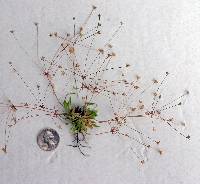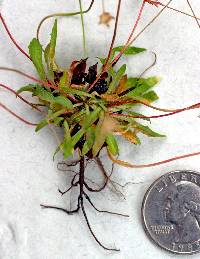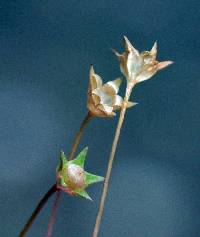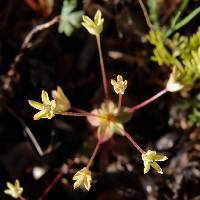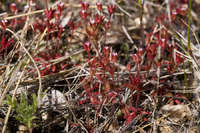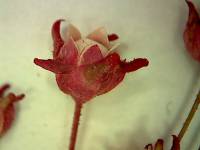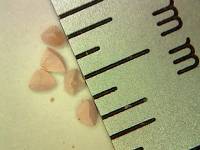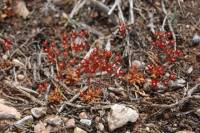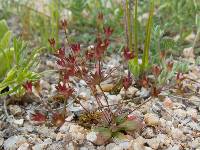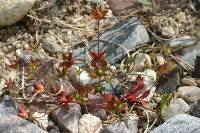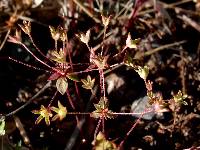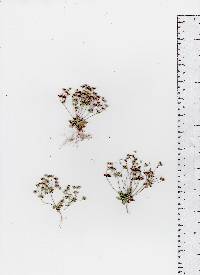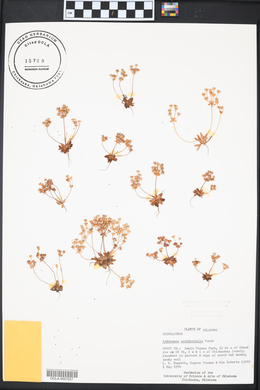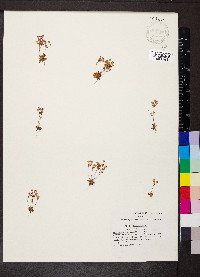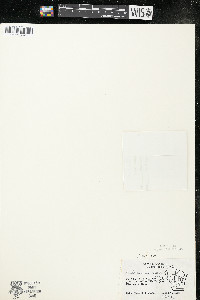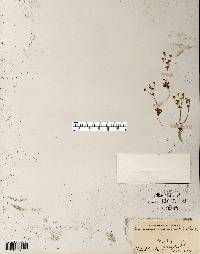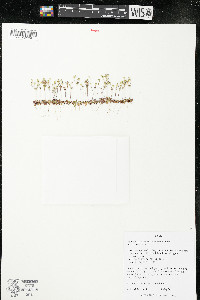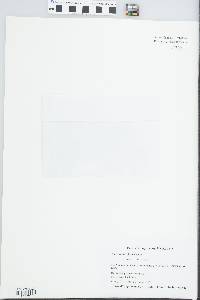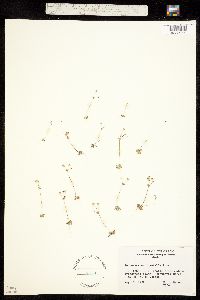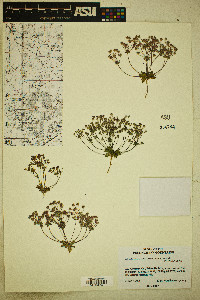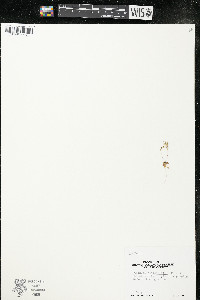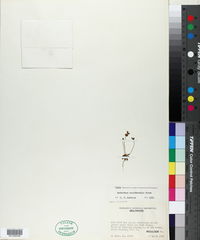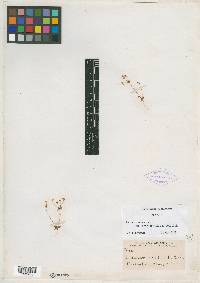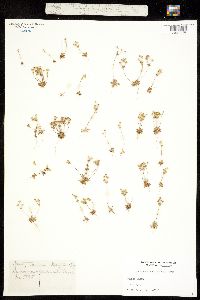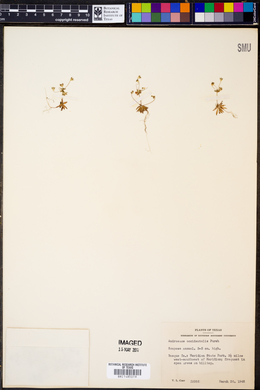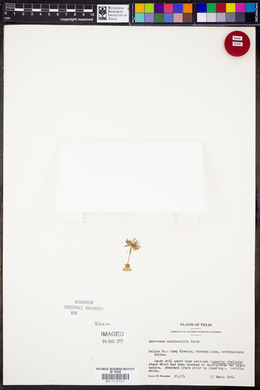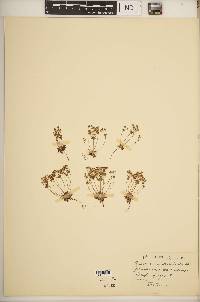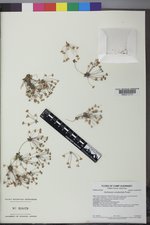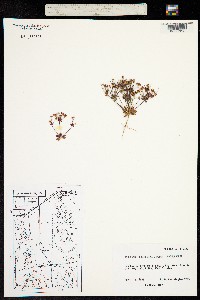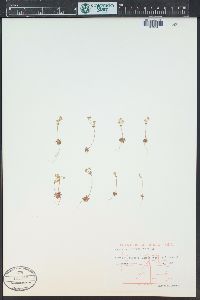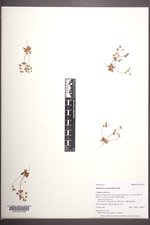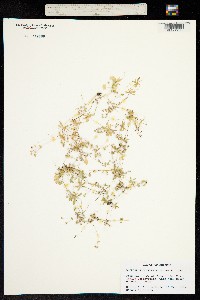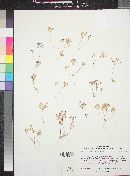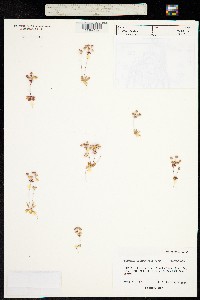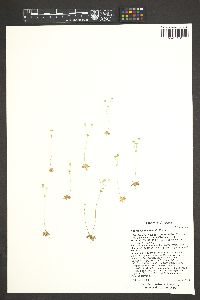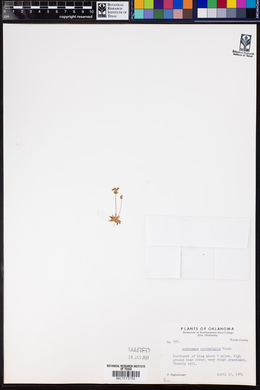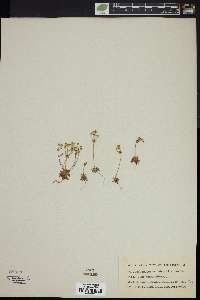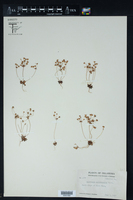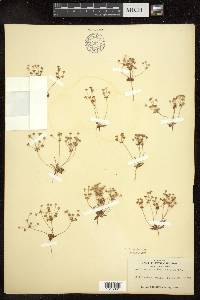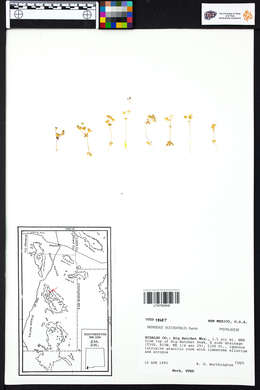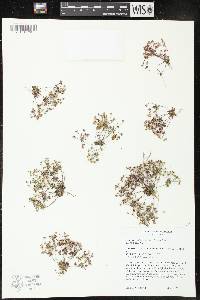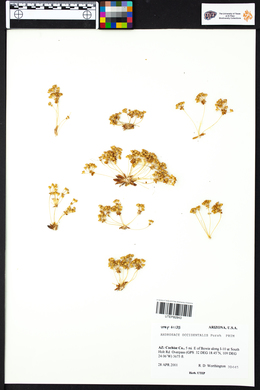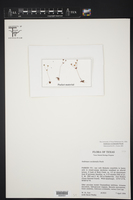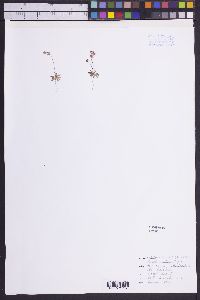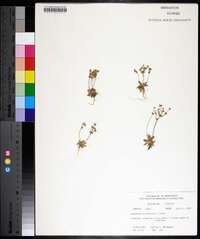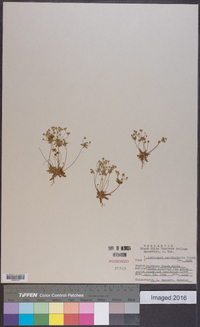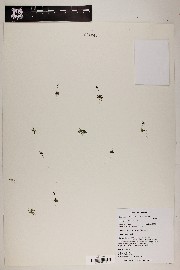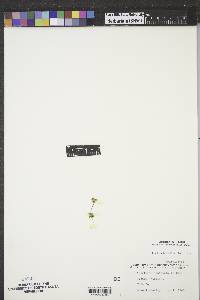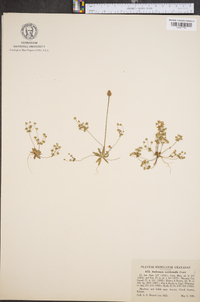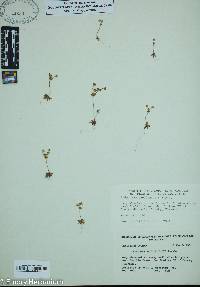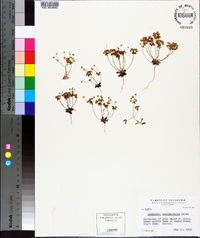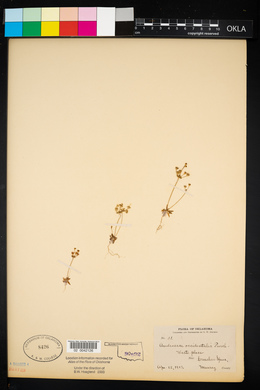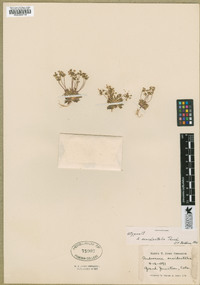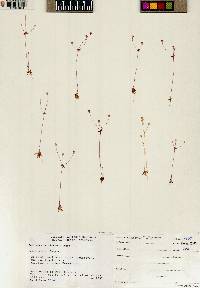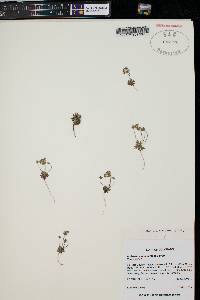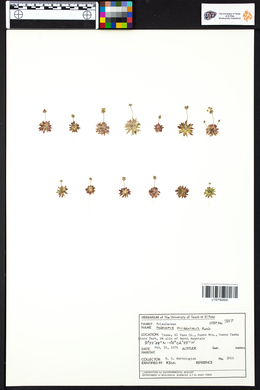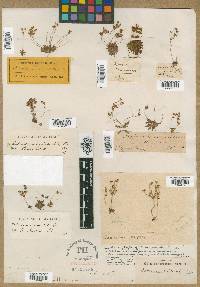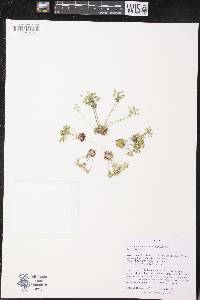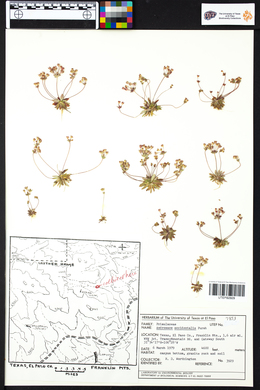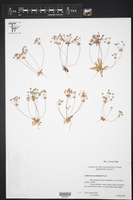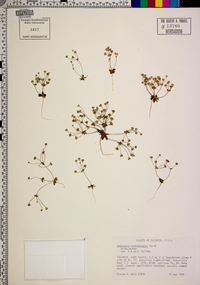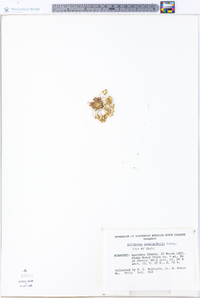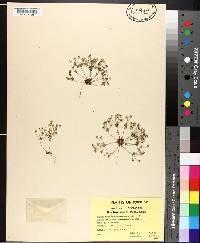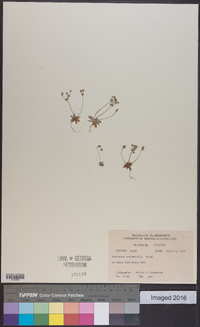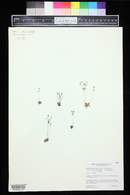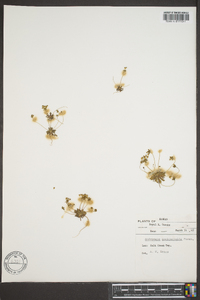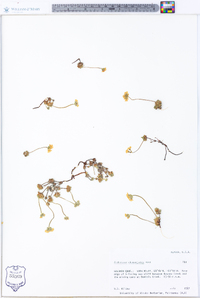Androsace occidentalis
|
|
|
|
Family: Primulaceae
Western Rock-Jasmine, more...western fairy candelabra, western rock jasmine, western rockjasmine
[Androsace arizonica (A. Gray) Derganc, moreAndrosace occidentalis var. arizonica (A. Gray) St. John, Androsace occidentalis var. occidentalis , Androsace occidentalis var. simplex (Rydb.) St. John, Androsace platysepala Wooton & Standl. , Androsace simplex] |
Plants annual, inconspicuous, not mat-forming. Leaves in single rosette; petiole obscure; blade lanceolate, oblanceolate, or spatulate, 5-30 × 4-9 mm, base obscurely narrowing to stem, margins with simple hairs, surfaces puberulent, hairs simple. Scapes 1-15, 2-10 cm, glabrescent to puberulent. Inflorescences 3-15-flowered; involucral bracts lanceolate to elliptic or ovate, relatively broad. Pedicels erect to arcuate, slender, unequal, 0.3-3 cm. Flowers: calyx broadly campanulate, ridged, 3-5 mm, lobes erect, broadly lanceolate, apex acute to obtuse; corolla tube equaling or shorter than calyx, limb ca. 3 mm diam. Capsules ± equaling calyx, 3-5 mm. 2n = 20. Flowering early-mid summer. Open, grassy meadows, sandy or gravelly open soils, often in disturbed areas; 300-1700 m; Alta., B.C., Man., Ont., Sask.; Ariz., Ark., Calif., Colo., Idaho, Ill., Ind., Iowa, Kans., La., Mass., Mich., Minn., Mo., Mont., Nebr., N.Mex., N.Dak., Ohio, Okla., S.Dak., Tex., Utah, Wis., Wyo. Androsace occidentalis is widespread across the central and western United States, extending into southern Canada. It is often confused with A. septentrionalis, with which it overlaps geographically somewhat in the western portion of its range. Androsace occidentalis is generally restricted to lower elevations and is distinguished by its broad involucral bracts and cup-shaped calyx. In A. septentrionalis, the involucral bracts are narrow and the calyx V-shaped at the base, a shape enhanced by the more prominent calyx ridges. Hybridization between A. occidentalis and A. septentrionalis has not been documented; some specimens from intermediate elevations in the Four Corners area show intermediate bract morphology and slight glandular pubescence, a characteristic of some southwestern populations of A. septentrionalis.
PLANT: 2-13 cm tall. LEAVES: 2.5-19 mm long, sessile; blade lanceolate, the upper surface generally with some short stiff hairs. INFLORESCENCE: with lance-ovate to ovate or ovate-elliptic bracts. FLOWERS: white or sometimes white with pinkish tint; calyx 2.8-5.2 mm long, hairy, the lobes half as long to equalling the tube; corolla shorter than the calyx. 2n = 20. NOTES: Rocky slopes and outcrops, gravelly or sandy washes, moist meadows and streamsides, from the Sonoran Desert to open pine forests: reported from all cos. except Navajo, La Paz and Yuma; 300-2400 m (1000-8000 ft); Feb-May; w Can s to IN, TX, NM, and AZ. REFERENCES: Cholewa Anita F. 1992. Primulaceae. Ariz.-Nev. Acad. Sci. 26(1)2 Cholewa 1992, Wiggins 1964, Kearney and Peebles 1969 Duration: Annual Nativity: Native Lifeform: Forb/Herb General: Small delicate annual herb to 10 cm tall, sparsely puberulent throughout. Leaves: Basal, narrowly obovate to oblanceolate or oblong, 1.5-4 mm wide, 4-15 mm long, obtuse to short-acuminate at apex, narrowed to short petiole or subsessile, entire or slightly denticulate, scapes several, ascending to erect, 1.5-5 cm long. Flowers: Umbels 2-15-flowered (usually 2-8-flowered), bracts subtending umbel ovate or elliptic, somewhat rhombic 2-5 mm long foliaceous, green; pedicels slender, 5-20 mm long, outer curved-ascending, inner erect or nearly so; calyx tube 2-2.5 mm in flower, green or often reddish, lobes ovate or narrowly triangular, 1.2-1.5 mm long in flower, green or reddish, spreading or even slightly reflexed in fruit. Fruits: Capsule about 3 mm in diameter. Ecology: Found on grassy hillsides and along streams and washes; 1,000-5,000 ft (305-1524 m); flowers February-April. Distribution: Most of northern N. Amer except for the east coast; south to s MEX. Notes: A small annual showing up only in early spring; distinguished by how delicate it is, the few diffuse stems arising from a basal rosette of leaves; each stem leading to a node where leaves surround the stem (actually invoucral bracts) and multiple flowers arise from the same point bearing cup-shaped calyces.Told apart from A. septentrionalis by the lance-ovate or ovate-elliptic involucral bracts, and the corolla being shorter than the calyx. Ethnobotany: This plant is used for postpartum hemorrhage, for birth injury, for internal pain, and as a -life medicine.- Etymology: Androsace from Green name for sea-plant from Greek andros, a man, male and sakos, a shield, while occidentalis means western. Synonyms: Androsace arizonica, A. occidentalis var. arizonica, A. occidentalis var. simplex Editor: SBuckley 2010, FSCoburn 2015 Lvs oblanceolate to oblong or oblong-obovate, to 3 cm, entire to denticulate, grayish-puberulent with simple hairs; scapes 1-many, pubescent with branched hairs; umbels 3-10-fld, the bracts 3-8 mm, resembling the lvs in shape, less than 4 times as long as wide; cal 4-5 mm, carinate below each lobe, the expanded, greenish, lance-ovate, pubescent lobes about equaling the nearly glabrous tube; cor white, scarcely exceeding the cal-tube, the limb 2.5 mm wide; 2n=20. Dry, usually sandy soil; Ind. to Man., w. to B.C. and Ariz. Apr. Gleason, Henry A. & Cronquist, Arthur J. 1991. Manual of vascular plants of northeastern United States and adjacent Canada. lxxv + 910 pp. ©The New York Botanical Garden. All rights reserved. Used by permission. From Flora of Indiana (1940) by Charles C. Deam Reported for the state by Dorner (Proc. Indiana Acad. Sci. 1903: 119. 1904), who says "somewhat abundant in lowland near Wea Creek." I have one of his specimens, and one from Knox County, without data, collected by W. S. Blatchley. It is to be noted that the area along Big Wea Creek has many western species such as Muhlenbergia cuspidata, Arenaria patula, Lithospermum incisum, and others. ...... Indiana Coefficient of Conservatism: C = 4 Wetland Indicator Status: FACU Diagnostic Traits: Winter annual mostly less than 10 cm tall; basal rosette leaves to 3 cm; flowers 3-10 in umbels; capsule fruit. |
|
|
|

